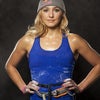I train for climbing six days a week. It’s tough on my body. Traveling constantly takes a toll, too. In order to progress athletically, one of the most important pieces of the puzzle is staying healthy and injury-free.
There are a lot of different recovery practices out there, but these are the six things that have worked best for me.
Cryotherapy
I first found out about cryotherapy at the in Santa Monica, California. (Full disclosure: Red Bull is one of my sponsors.) The technique is sort of like a concentrated, intense ice bath. Essentially you stand in a deep-freezing chamber filled with liquid nitrogen for three to five minutes. The tank reaches temperatures as low as minus 200 degrees. During this process, your blood vessels constrict, which alleviates inflammation and pain throughout the body. I do this before or after every workout.
I live in Boulder, Colorado, so I go to for this therapy.
Graston
I see my physical therapist, , once a week when I'm home. He’ll use tools like Graston—a manual soft-tissue release technique that’s sort of like a massage—on my forearms. I’ve always felt that if a massage doesn’t feel painful, it’s not really productive for recovery. The body works like a chain: if there is tension in one point of your body, it’s probably related to an issue elsewhere.
Dry Needling
Dry needling is a specific localized treatment that uses—you guessed it—needles to relieve pain. Unlike acupuncture, dry needling pinpoints inflamed problem areas in your body. Charlie inserts the needle into trigger-point areas of my muscles to treat myofascial pain. He will also hook these needles up to an electromagnetic stimulator to enhance blood flow. I do dry needling when I have a specific muscle inflammation or tension, usually in my lats, upper back, and neck.
Infrared Sauna
The infrared sauna doesn’t have much solid research to back it up as a recovery tool, but I like it after a hard workout. I’ve also found it to be a good remedy to combat a cold or post-travel jet lat. These saunas heat the body from the inside out via infrared light waves, instead of warming through surface heat like a traditional sauna. Typically I’ll spend about 30 minutes in one. Most high-end gyms or recovery physio centers have these.
Foam Rolling
Foam rolling is a really easy form of recovery. I bring my foam roller when I travel and use it in my hotel room after long flights, after climbing outside all day, and sometimes before climbing. My back gets really stiff, and I find that when I roll my spine it releases a lot of the pressure. Using a foam roller can be effective if used for just for a few minutes intermittently, but it is a healthy and easy habit to develop. I use the from Pro-Tec Athletics, another one of my sponsors.
Rest
Climbing is a year-round sport. If you can travel, there’s always a place to climb that’s in season. But you can’t expect peak performance out of your body year-round. You need rest. Typically, I take the month of December off. This isn’t to say that you won’t find me in the climbing gym, but more than likely I’ll be on the ski hill or with ice axes, mixing it up. Time off from training is important to enable your body and mind to recharge. When I’m in season, I typically go through two-to-three-month training blocks with a goal in mind. At the end of this concentrated period of training, I set off for my project. Afterward it’s important to take time to appreciate what you have put your body and mind through.


